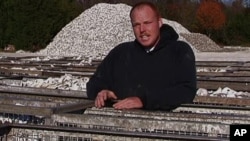More than 50 restaurants, caterers and seafood wholesalers from Washington DC, Maryland and Virginia are participating in an unusual recycling program started earlier in the year by the Oyster Recovery Partnership. In nine months, they donated two million oyster shells to the University of Maryland to help restore the decimated oyster population in the Chesapeake Bay.
For anyone who craves oysters, one of the most famous spots in Washington is the Old Ebbitt Grill.
"We serve between 1500 and 2000 oysters a day, and that obviously creates a lot of waste," said Christian Guidi who manages the restaurant.
In the past, these oyster shells would end up in the garbage, but that changed this year when the Old Ebbitt Grill found a new purpose for the used shells.
The restaurant is recycling them to help restore the declining oyster population in the Chesapeake Bay.
The Oyster Recovery Partnership picks up the used shells and brings them to Michael McWilliams.
"We send them through a washing process where they are sent through a machine hit with water," said Michael McWilliams with the Oyster Recovery Partnership.
At the University of Maryland's Center for Environmental Science, a giant machine thoroughly cleans the shells. They sit in the sun for a year before they're ready to become homes for baby oysters.
That happens here, at the university's hatchery.
"It is a critical species in the overall health of the Chesapeake Bay," said Don Meritt heads the oyster recovery program.
Meritt says the Chesapeake Bay is unhealthy because of the decline in the oyster population from erosion, disease and overharvesting.
Oysters and other filter feeders form community reefs that clean the water in the bay.
"Our real goal here is to try to bring healthy oyster populations back to the Chesapeake Bay so that we can help restore a healthy Chesapeake Bay not just a healthy oyster population but a healthy bay," added Meritt.
The scientists start by creating the right environment for oysters to reproduce. Hundreds of millions of oyster larvae are then placed in these tanks where they'll eat a well balanced diet of specially formulated algae -- and grow.
"If we want the oysters to be happy we have to give them good food," said Meritt.
After two to four weeks, the larvae need to attach themselves to a hard surface, like a shell. The baby oysters in these tanks will eventually be taken out to the bay.
In about six years, the oysters should be big enough for other organisms, like mussels and barnacles, to attach themselves to the oyster shells making this the beginning of an oyster reef community.
Meritt says it's a process that takes time.
"We didn't get to this crisis in a few years and we're not going to get out of it in a few years. It's going to take a concerted effort over a long period of time," explained Meritt.
Meritt says every recycled shell is needed because it will take several decades before the oyster population is fully restored.










